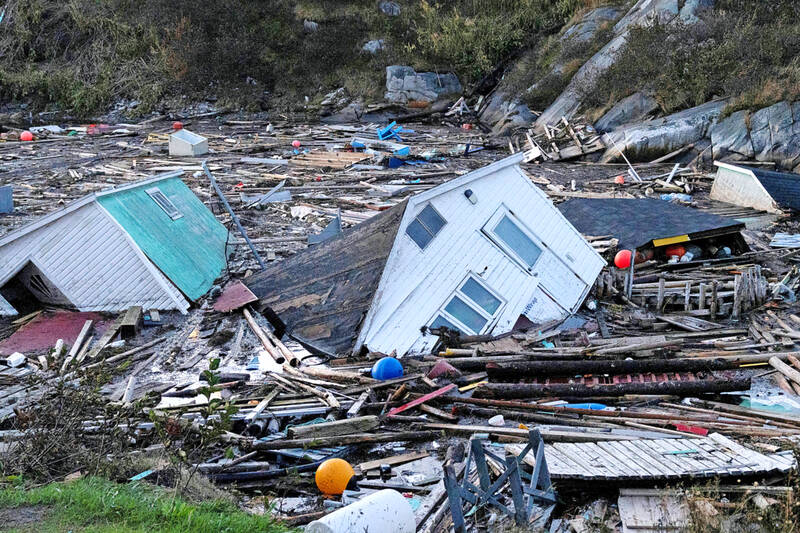Parts of eastern Canada suffered “immense” devastation, officials said on Sunday after storm Fiona swept houses into the sea and caused major power outages, as the Caribbean and Florida braced for intensifying Tropical Storm Ian.
Canadian authorities have now confirmed two deaths caused when Fiona, then a post-tropical cyclone, tore into Nova Scotia and Newfoundland early on Saturday.
Fiona had earlier claimed seven lives as it roared through the Caribbean at the start of a week of havoc.

Photo: Reuters
Officials on Prince Edward Island on Sunday confirmed the death of one person there, though there were few details, and officials found the body of a 73-year-old woman believed to have been swept from her home in Newfoundland. She apparently was sheltering in her basement when waves broke through.
The storm packed intense winds of 130kph when it arrived with force rarely seen in eastern Canada, bringing torrential rain and waves of up to 12m.
“The devastation is immense,” Nova Scotia Premier Tim Houston told reporters. “The magnitude of the storm is incredible.”
Storm surges swept at least 20 homes into the sea in the town of Channel-Port aux Basques, on the southwestern tip of Newfoundland.
Channel-Port aux Basques Mayor Brian Button described “a total war zone” in the coastal community. About 200 residents had been evacuated before the storm hit.
On Sunday, residents were reckoning with the damage.
“Some people have lost everything, and I mean everything,” Button told CBC News. “The sea was taking back the land and we were getting separated. A lot of our homes are built along the coastline along the Atlantic Ocean. Down there, Fiona just wiped out parts of that.”
Tempers were fraying as residents tried to return to their homes — or what was left of them.
“I know people are showing up at the barricades angry this morning, and wanting to move in and go check up on their properties,” Button said in a live video on Facebook. “You’ve got to give us a little bit of time... Unfortunately, this is going to take days, could take weeks, could take months in some cases.”
More than 300,000 people were without electricity across five provinces on Sunday after the storm felled trees, ripped roofs from buildings and damaged power lines, officials said.
Hundreds of utility crews were working to restore power.
Houston told CBC the Canadian military had been deployed to help clear trees and roads.
Canadian Emergency Preparedness Minister Bill Blair said the Canadian armed forces would also provide assistance to Newfoundland’s cleanup efforts. It was the third province to request federal military assistance, after Nova Scotia on Saturday and Prince Edward Island earlier on Sunday.
Television images showed a long line of vehicles and people on foot lining up to get gas for generators in Cape Breton, an island off Nova Scotia, where dozens had spent the night in relief centers operated by the Canadian Red Cross.
On Prince Edward Island, Charlottetown Police Chief Brad MacConnell pleaded with residents to stay inside as recovery efforts continued.
“We ask people to stay home unless absolutely necessary,” he told CBC, adding that there is “a lot of devastation” and hardly an area of the city that had not been significantly affected.
Canadian Prime Minister Justin Trudeau wrote on Twitter that he had met again with his Incident Response Group to ensure that “resources are available to help those affected by the storm.”
By Sunday, with a waning Fiona dissipating over the Labrador Sea, the nation’s environmental agency said all warnings had been canceled.
Further south, parts of the Caribbean as well as the US state of Florida were preparing for Tropical Storm Ian, which the US National Hurricane Center (NHC) said was forecast to become a hurricane yesterday and a major hurricane the following day.
Packing winds of near 97kph and getting stronger, the storm was expected to pass near the Cayman Islands, either near or over western Cuba, and then head toward Florida, the NHC said.
A hurricane warning is in effect for parts of Cuba — where the storm was forecast to “produce significant wind and storm surge” — as well as the British territory of Grand Cayman, the NHC said.
Florida Governor Ron DeSantis on Saturday said that he had declared a state-wide emergency in preparation for the storm, warning on Twitter that “Floridians should take precautions.”
Authorities in several Florida municipalities, including Miami, Fort Lauderdale and Tampa, began distributing free sandbags to residents to help them protect their homes from the risk of flooding.
“It’s never too early to prepare,” Tampa Mayor Jane Castor wrote on Twitter.

Kehinde Sanni spends his days smoothing out dents and repainting scratched bumpers in a modest autobody shop in Lagos. He has never left Nigeria, yet he speaks glowingly of Burkina Faso military leader Ibrahim Traore. “Nigeria needs someone like Ibrahim Traore of Burkina Faso. He is doing well for his country,” Sanni said. His admiration is shaped by a steady stream of viral videos, memes and social media posts — many misleading or outright false — portraying Traore as a fearless reformer who defied Western powers and reclaimed his country’s dignity. The Burkinabe strongman swept into power following a coup in September 2022

‘FRAGMENTING’: British politics have for a long time been dominated by the Labor Party and the Tories, but polls suggest that Reform now poses a significant challenge Hard-right upstarts Reform UK snatched a parliamentary seat from British Prime Minister Keir Starmer’s Labor Party yesterday in local elections that dealt a blow to the UK’s two establishment parties. Reform, led by anti-immigrant firebrand Nigel Farage, won the by-election in Runcorn and Helsby in northwest England by just six votes, as it picked up gains in other localities, including one mayoralty. The group’s strong showing continues momentum it built up at last year’s general election and appears to confirm a trend that the UK is entering an era of multi-party politics. “For the movement, for the party it’s a very, very big

ENTERTAINMENT: Rio officials have a history of organizing massive concerts on Copacabana Beach, with Madonna’s show drawing about 1.6 million fans last year Lady Gaga on Saturday night gave a free concert in front of 2 million fans who poured onto Copacabana Beach in Rio de Janeiro for the biggest show of her career. “Tonight, we’re making history... Thank you for making history with me,” Lady Gaga told a screaming crowd. The Mother Monster, as she is known, started the show at about 10:10pm local time with her 2011 song Bloody Mary. Cries of joy rose from the tightly packed fans who sang and danced shoulder-to-shoulder on the vast stretch of sand. Concert organizers said 2.1 million people attended the show. Lady Gaga

SUPPORT: The Australian prime minister promised to back Kyiv against Russia’s invasion, saying: ‘That’s my government’s position. It was yesterday. It still is’ Left-leaning Australian Prime Minister Anthony Albanese yesterday basked in his landslide election win, promising a “disciplined, orderly” government to confront cost-of-living pain and tariff turmoil. People clapped as the 62-year-old and his fiancee, Jodie Haydon, who visited his old inner Sydney haunt, Cafe Italia, surrounded by a crowd of jostling photographers and journalists. Albanese’s Labor Party is on course to win at least 83 seats in the 150-member parliament, partial results showed. Opposition leader Peter Dutton’s conservative Liberal-National coalition had just 38 seats, and other parties 12. Another 17 seats were still in doubt. “We will be a disciplined, orderly